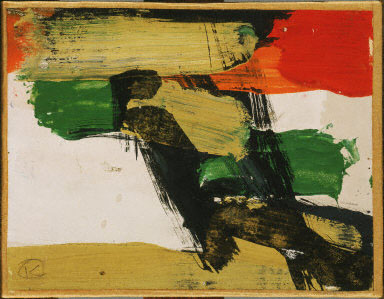This summer has been far too much of a muchness: too much travel, too much work, too much stress. Mrs. T and I had planned to take a week off, but our plan was scrapped when my mother fell ill, and I ended up going straight from reviewing shows all over the country to opening one of my own in Florida. By the time I arrived in Washington, D.C., on Monday, I was as frazzled as I’ve ever been.
 Fortunately, the friend with whom I had dinner that evening took one look at me and insisted that I do something just for fun as soon as humanly possible, so I strolled over to the Phillips Collection the next day and spent an hour looking at paintings. Not only had a month gone by since my last walk–that’s how busy I’ve been–but I hadn’t set foot in my favorite museum for two years. It wasn’t that I’d forgotten how much I love the Phillips, but I confess to having been startled by how comforting it was for me to visit its galleries after so prolonged an absence. No sooner did I find my way to Paul Klee’s Arrival of the Jugglers than I felt the world start to right itself.
Fortunately, the friend with whom I had dinner that evening took one look at me and insisted that I do something just for fun as soon as humanly possible, so I strolled over to the Phillips Collection the next day and spent an hour looking at paintings. Not only had a month gone by since my last walk–that’s how busy I’ve been–but I hadn’t set foot in my favorite museum for two years. It wasn’t that I’d forgotten how much I love the Phillips, but I confess to having been startled by how comforting it was for me to visit its galleries after so prolonged an absence. No sooner did I find my way to Paul Klee’s Arrival of the Jugglers than I felt the world start to right itself.
Henri Matisse made an oft-quoted remark about his art that deserves closer consideration than it tends to get:
What I dream of is an art of balance, of purity, and tranquility, without any disquieting or preoccupying subject matter, an art that could be for every mental worker, for the businessman as well as the man of letters, for example, a tonic, a cerebral calmative, something like a good armchair that relaxes him from his physical fatigue.
Those of us who spend our lives immersed in the world of art have an unfortunate way of overlooking its unique ability to serve as a remedy for the trials of life. We think of art as something to do, not something to use, and many of us also suffer from the mistaken notion that art must be challenging in order to be good. On some level, of course, that’s perfectly true, but there are many different ways of experiencing art, all of which are valid as far as they go. (There are nine and sixty ways of constructing tribal lays,/And every single one of them is right!) To take uncomplicated pleasure from beauty is a wholly worthy activity, and to do it in the hope of finding surcease from whatever may be troubling us is no less worthy.
 One of the reasons why I love the Phillips is because it never fails to surprise me. Today I ran across a small untitled painting by Franz Kline that I’d never seen before, and I delighted in its unpredictability. Who knew that Kline, that most monochromatic of modernists, could make such startling use of color? But I’d come to the Phillips to rest my spirit, and as I gazed at The Open Window and The Garden at Les Lauves for the umpteenth time, I felt the calm of which Matisse spoke, the comfort of great art whose idiosyncrasies are as familiar as the quirks of an old friend.
One of the reasons why I love the Phillips is because it never fails to surprise me. Today I ran across a small untitled painting by Franz Kline that I’d never seen before, and I delighted in its unpredictability. Who knew that Kline, that most monochromatic of modernists, could make such startling use of color? But I’d come to the Phillips to rest my spirit, and as I gazed at The Open Window and The Garden at Les Lauves for the umpteenth time, I felt the calm of which Matisse spoke, the comfort of great art whose idiosyncrasies are as familiar as the quirks of an old friend.
I returned to the hotel refreshed, took a nap, then went to the Studio Theatre to see a new play, one to whose newness I would surely have been unequal had I not spent the afternoon communing with Bonnard and Cézanne. Today I return to Connecticut and Mrs. T, and I dare say I’ll appreciate her even more than usual, too. There are worse reasons to go to museums–or to make art.
